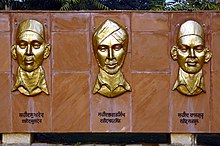Legacy and Memorials
Bhagat Singh remains a significant figure in Indian iconography to the present day.[91] However, his memory however, defies categorisation and presents problems for various groups that might try to appropriate it. Pritam Singh, a professor who has specialised in the study of federalism, nationalism and development in India, notes that
- On 15 August 2008, an 18-foot tall bronze statue of Singh was installed in the Parliament of India, next to the statues of Indira Gandhi and Subhas Chandra Bose.[93] A portrait of Singh and Dutt also adorns the walls of the Parliament House.[94]
- The place where Singh was cremated, at Hussainiwala on the banks of the Sutlej river, became Pakistani territory during the partition. On 17 January 1961, it was transferred to India in exchange for 12 villages near the Sulemanki Headworks.[65] Batukeshwar Dutt was cremated there on 19 July 1965 in accordance with his last wishes, as was Singh's mother, Vidyawati.[95] The National Martyrs Memorial was built on the cremation spot in 1968[96] and has memorials of Singh, Rajguru and Sukhdev. During the 1971 India–Pakistan war, the memorial was damaged and the statues of the martyrs were removed by the Pakistani Army. They have not been returned[65][97] but the memorial was rebuilt in 1973.[95]
- The Shaheedi Mela (Punjabi: Martyrdom Fair) is an event held annually on 23 March when people pay homage at the National Martyrs Memorial.[98] The day is also observed across the Indian state of Punjab.[99]
- The Shaheed-e-Azam Sardar Bhagat Singh Museum opened on the 50th death anniversary of his death at his ancestral village,Khatkar Kalan. Exhibits include Singh's half-burnt ashes, the blood-soaked sand, and the blood-stained newspaper in which the ashes were wrapped.[100] A page of the first Lahore Conspiracy Case's judgement in which Kartar Singh Sarabha was sentenced to death and on which Singh put some notes is also displayed,[100] as well as a copy of the Bhagavad Gita with Bhagat Singh's signature, which was given to him in the Lahore Jail, and other personal belongings.[101][102]
- The Bhagat Singh Memorial was built in 2009 in Khatkar Kalan at a cost of ₹168 million (US$2.5 million).[103]
- The Supreme Court of India established a museum to display landmarks in the history of India's judicial system, displaying records of some historic trials. The first exhibition that was organised was the Trial of Bhagat Singh, which opened on 28 September 2007, on the centenary celebrations of Singh's birth.[66][67]
- In September 2007, the Governor of Punjab, Pakistan, Khalid Maqbool, announced that a memorial to Singh would be displayed at the Lahore Museum. According to the governor, Singh was the first martyr of the subcontinent and his example was followed by many youths of the time.[104][105] However, the promise was not fulfilled.[106]
Modern day
The youth of India still draw tremendous amount of inspiration from Singh.[107][108][109] He was voted the "Greatest Indian" in a poll by the Indian magazine India Today in 2008, ahead of Bose and Gandhi.[110] During the centenary of his birth, a group of intellectuals set up an institution named Bhagat Singh Sansthan to commemorate him and his ideals.[111] The Parliament of India paid tributes and observed silence as a mark of respect in memory of Singh on 23 March 2001[112] and 2005.[113] In Pakistan, after a long-standing demand by activists from the Bhagat Singh Memorial Foundation of Pakistan, the Shadman Chowk square in Lahore, where he was hanged, was renamed as Bhagat Singh Chowk. This move was challenged in a Pakistani court and held.[114][115] On 6 September 2015, the Bhagat Singh Memorial Foundation filed a petition in the Lahore high court and again demanded the renaming of the Chowk to Bhagat Singh Chowk.[116]
Movies Several films have been made portraying the life and times of Singh. The first is the long-ignored Shaheed-e-Azad Bhagat Singh(1954), followed by Shaheed Bhagat Singh (1963), starring Shammi Kapoor as Bhagat Singh. Two years later, Manoj Kumar portrayed Bhagat Singh in an immensely popular and landmark film, Shaheed. Three major films about Singh were released in 2002 but all were unsuccessful: Shaheed-E-Azam, 23 March 1931: Shaheed and The Legend of Bhagat Singh. The 2006 film Rang De Basanti is a film drawing parallels between revolutionaries of Bhagat Singh's era and modern Indian youth.[117]
In 2008, Nehru Memorial Museum and Library (NMML) and Act Now for Harmony and Democracy (ANHAD), a non-profit organisation, co-produced a 40-minute documentary on Bhagat Singh entitled Inqilab, directed by Gauhar Raza.[118][119]
Theatre Singh, Sukhdev and Rajguru have been the inspiration for a number of plays in India and Pakistan, that continue to attract crowds.[120][121][122]
Songs Although created by Ram Prasad Bismil, the patriotic Hindustani songs, "Sarfaroshi ki Tamanna" ("The desire to sacrifice") and "Mera Rang De Basanti Chola" ("O Mother! Dye my robe the colour of spring"[123]) are largely associated with Singh's martyrdom and have been used in a number of related films.[124]










0 comments:
Post a Comment